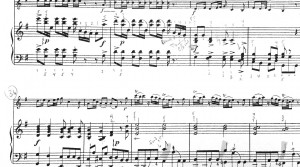Roughly 50 years after some of Stravinsky’s most influential works, Arthur Berger published his paper “Problems of Pitch Organization in Stravinsky .” There he attempted to define a new theory about Stravinsky’s music and, in the process, coined the term “octatonic.” In contrast, in as early as 1906 Russian music theorist Boleslav Yavorsky (1877–1942) was documenting theories that would influence modern Russian music theory and would be applicable to the music of Rimsky-Korsakov, Scriabin, Stravinsky, and Prokofiev.
Piano
I am in the middle of my Master’s in Composition through the University of Birmingham, UK. During this final semester, I need to finish a piano concerto, clean up several shorter works, and write a 5000 word commentary on my portfolio of 45 minutes of new music. To help make time for this, I have shortened my semester of private teaching, scheduled no fall nor winter recitals, and challenged all of my older students to learn three new works largely independently from me.
The idea of independent learning with my older students originates in the concept of the Accomplished Learner – the graduating high school student who is both an accomplished pianist and a capable self-learner. This concept, first introduced to me at a Suzuki Principles in Action course, has proved a useful metric for my teaching.
My need to lighten my teaching load became an opportunity to push my students closer to becoming an Accomplished Learner. Using the guidelines offered in the Gerald Klickstein’s fabulous book The Musician’s Way: A Guide to Practice, Performance, and Wellness, I created a packet intended to lead my students through the steps of learning a piece independently.
Summer is almost here. The academic year’s schedule is coming to a close, and my students are signing up for lessons on the days that I will be teaching during the summer.
Traditionally, I’ve had a binder of available days on which students would sign up for a lesson. Here’s an example signup sheet from last summer:
This year, I’m trying out online lesson scheduling. While there are piano teacher specific services which might cover this well (e.g., Music Teacher’s Helper), my needs are more modest than what full blown studio management software offers. I examined a few options for online appointment schedulers, and I implemented my summer scheduling through Acuity Scheduling.
Below is the second part of my Write Like Mozart Week 5 Notes that I sent my students last year when we took the Write Like Mozart class together. The Write Like Mozart class is online again at the time of these posts. Each of these posts are timed to match the current week of that class.
In this short installment, I offer hints on writing 1:1, 2:1, and mixed note value counterpoint.
This is the eighth post in this series.
You may know that I am a fan of Coursera, an aggregate site of short and usually free online courses presented by University professors from around



